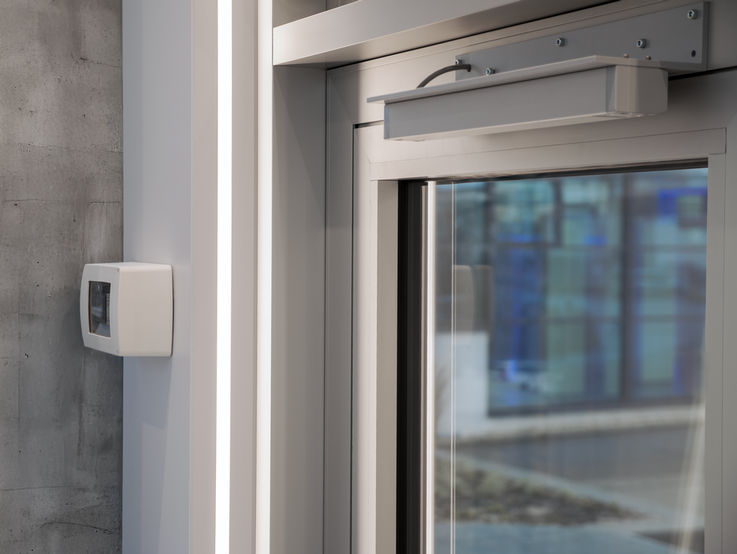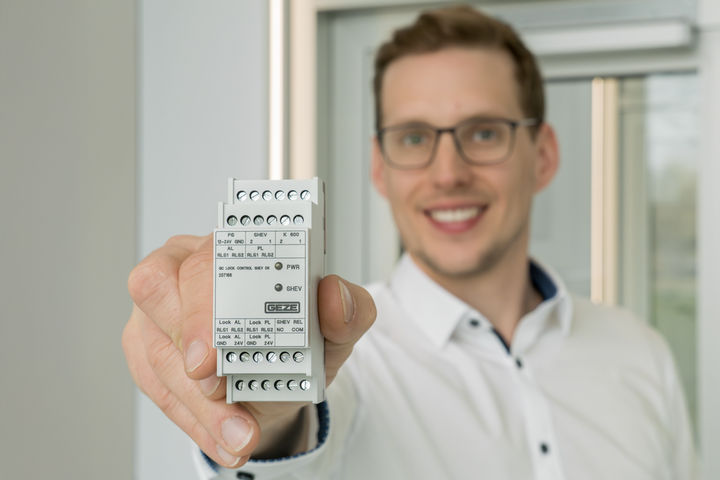Safe SHEV air inlet doors: tips for planning and assembly
Efficient smoke and heat ventilation can save lives and protect buildings in the event of a fire. Our smoke and heat extraction expert Dr. Dominik Landerer explains the central role of fresh air intakes for effective smoke and heat extraction systems in buildings and provides practical tips for planning and implementing SHEV air inlet doors.
Why are air inlet doors crucial for the effectiveness of smoke and heat extraction systems?
Smoke and heat extraction systems help to extract smoke and heat and lower the temperature in the event of a fire in a building. This facilitates (self-)rescue and helps people fight fires efficiently. Smoke and heat extraction systems usually consist of windows, flaps or ventilation openings that are opened automatically to direct dangerous flue gases outside. Fresh air intakes, such as air inlet doors, are an important component of smoke and heat extraction systems. In the event of a fire, they are used to let fresh air flow into the building. The fresh air intakes ensure that a controlled air flow is created by a chimney effect, which supports the dissipation of smoke and heat and thus improves the efficiency of the thermal lift. Smoke and heat extraction systems thus make an essential contribution to fire protection measures, helping to protect lives, property and buildings in an emergency.
Are air inlet openings mandatory?

GC Lock Control SHEV acts as a central connection point for all system parts that need to be connected to the SHEV panel. This facilitates assembly and minimises the effort required for cable routing. © GEZE GmbH
Yes, fresh air intakes are prescribed in many cases, especially in connection with smoke and heat extraction systems in escape and rescue routes.
The exact requirements for air inlet doors depend on various factors, such as the size, type and use of the building, as well as the specific fire protection regulations for the building types, which are specified in the respective building code of a federal state. In many cases, air inlet doors are required to ensure that the smoke and heat extraction system is functioning properly and that the safety of people in the building is guaranteed.
What are some of the typical problems that arise during the planning and assembly of SHEV air inlet doors?

Dr. Dominik Landerer, Windows Product Management Team Leader, presents the new GC Lock Control SHEV, an auxiliary control unit for SHEV air inlet doors. © GEZE GmbH

Central control for smoke and heat extraction system air inlet doors, simplifies cabling and ensures motor lock operation in the event of an alarm.
SHEV air inlet doors are usually also multifunctional doors. In normal operation, for example, they should enable barrier-free access or prevent unauthorized access, which places additional demands on the door. In the event of an alarm, however, it is crucial that the air inlet door can be quickly unlocked and opened. Therefore, all components of the SHEV air inlet door, such as the motor locks, must be connected to the SHEV panel in order to be supplied with emergency power in the event of an alarm. One of the main challenges is often the position of the SHEV panel. This is not always installed near the door, which means that long and often complicated cable connections are required. This increases the complexity of the overall installation and can lead to additional problems.
How can these challenges of complex smoke and heat extraction systems be solved?
GEZE offers a comprehensive smoke and heat extraction solution that includes the SHEV control panel, door drives, self-locking panic locks and our latest product, the additional control unit for motor locksGC Lock Control SHEV. The GC Lock Control SHEV ensures the safe operation of motor locks on an SHEV air inlet door in the event of an alarm and also functions as a central connection point for all system parts to the smoke and heat extraction system. This central connection point considerably simplifies the cabling, as only two cables are needed from the air inlet door to the SHEV panel. Standard motor locks can be connected to the additional control units for motor locks. This means that all components of a smoke and heat extraction system can be combined with each other, even if motor locks have already been set.
Another special feature is the option to connect a DC-to-DC converter to the GC Lock Control SHEV. This means that not only 24 V motor locks can be operated, but also 12 V motor locks or even a combination of both variants, ensuring added planning flexibility.
What mounting options does the GC Lock Control SHEV offer?

The GC Lock Control SHEV auxiliary controller allows for different mounting options on a 35 mm top hat rail. © GEZE GmbH
The GC Lock Control SHEV auxiliary controller is designed as a top hat rail housing with two horizontal pitches, which offers various mounting options on a 35 mm top hat rail.
The following options are available:
- Assembly in surface-mounted housing: The system is integrated in a GEZE surface-mounted housing together with a GEZE top-hat rail power supply and, if necessary, a DC-to-DC converter, to enable a simple and clear installation.
- Installation in a control cabinet: Another option is assembly in a control cabinet, which ensures a protected and tidy arrangement.
These flexible assembly options make it easy to adapt the smoke and heat extraction system to the specific structural requirements of the respective project.
What factors need to be considered during assembly and commissioning?
Assembly and commissioning of the GC Lock Control SHEV is "plug and play": First, the SHEV panel, the power supply and the appropriate motor locks and K600 retractable arm drives are connected to the GC Lock Control SHEV – all according to the clear specifications on the top hat rail housing. If necessary, a DC-to-DC converter (24V/12V-DC) is integrated for 12 V DC motor locks. The system is then ready for operation: as soon as the supply voltage is applied, the power LED lights up green, confirming that everything is connected correctly. In addition, the behaviour in normal operation and in the event of an alarm can be checked so that the functionality of the system is quickly ensured. This ease of use and the quick process make assembly and commissioning a stress-free experience for everyone involved.
It is important that the customer receives comprehensive instruction after commissioning. All the necessary documents are provided, and the customer is informed about maintenance requirements.
Is regular maintenance of the supply air inlet system mandatory?
Professional maintenance not only contributes to the durability of the system, but also minimises potential risks and ensures smooth operation in everyday life and safety in case of an emergency. Regular maintenance (at least once a year) is mandatory for smoke and heat extraction systems. This maintenance must be carried out by a suitably qualified expert, such as a GEZE service technician, who will ensure that all components are working properly and meet the applicable safety standards.
Speaking of emergencies: the GC Lock Control SHEV offers a high level of safety in case of problems such as a power failure. It prevents the motor locks from consuming the battery capacity of the SHEV panel during a power failure. Here is how it works: if the building loses power, the SHEV panel continues to supply all connected components with power from the rechargeable batteries. This emergency power supply must be maintained for up to 72 hours. If anyone walks through the air inlet door during this time, the components put a strain on the batteries and reduce their capacity – the GC Lock Control SHEV prevents this and ensures that the voltage for the motor locks always remains constant in the event of an alarm.
Despite the complex requirements placed on the system, our solution for SHEV air inlet doors is easy to install and highly flexible, thus ensuring safety and peace of mind for building planners, installation companies, and operators.
Dr Dominik Landerer, Windows Product Management Team Lead at GEZEEverything from a single source: Reliable functionality and planning
Our solutions include a reliable and tested combination of SHEV panel, power supply, suitable motor locks and swing door drives for air inlet systems. These components meet the highest standards of comfort and safety, ensuring convenient daily operation and safe smoke extraction in the event a smoke and heat extraction system is activated. In addition, our smoke and heat extraction solutions allow for a high degree of design and planning freedom when it comes to the design of SHEV air inlet doors, both for manual and automated daily operation.
Your advantage: The entire system can be obtained from a single source. Both fabricators and dealers have just one point of contact for all system components. This simplifies coordination and ensures standardised cable plans, for example, which saves you time and work.
Advantages for fitters, electricians and service technicians at a glance:
- Quick and easy installation and commissioning
- Clearly positioned inputs and outputs for easy installation
- Top hat rail housing with screw-type terminals for quick wiring
- Function check via LED status display of the power supply and the smoke and heat extraction system signal
- Use of standard motor locks (24 V and 12 V) for unlimited flexibility
- Standardised cable plans for SHEV air inlet doors to simplify installation
From planning to successful implementation: our services for you
Put your trust in our expertise to successfully handle your projects. Our GEZE experts for fire protection and smoke and heat extraction systems are on hand to support you with their extensive expertise and knowledge. We understand the challenges you face in planning and implementation, and offer you safe, reliable and customised solutions for all doors and windows, without compromises.
We start providing advice as early as possible so that we can inform you about the possible complex interactions surrounding smoke and heat extraction systems and fire protection. In doing so, we not only take technical aspects into account, but also point out important liability issues so that they can be minimised and avoided.
Tip: Our free fire protection white paper provides you with essential information on fire protection regulations and standards for fire protection doors, door closers, drives and hold-open systems.
We support you in fully utilising your design and planning capabilities. Should restrictions or alternative solutions be necessary, we will be at your side to advise you and help you make the best decisions for your project.



